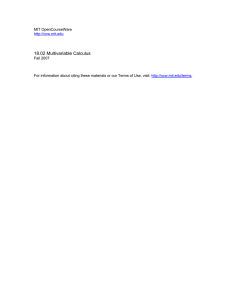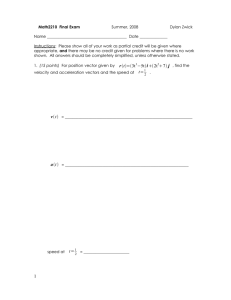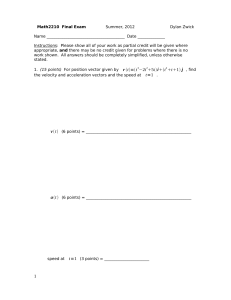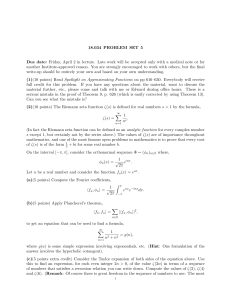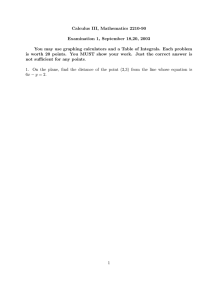18.02 Problem Set 8 – ...
advertisement
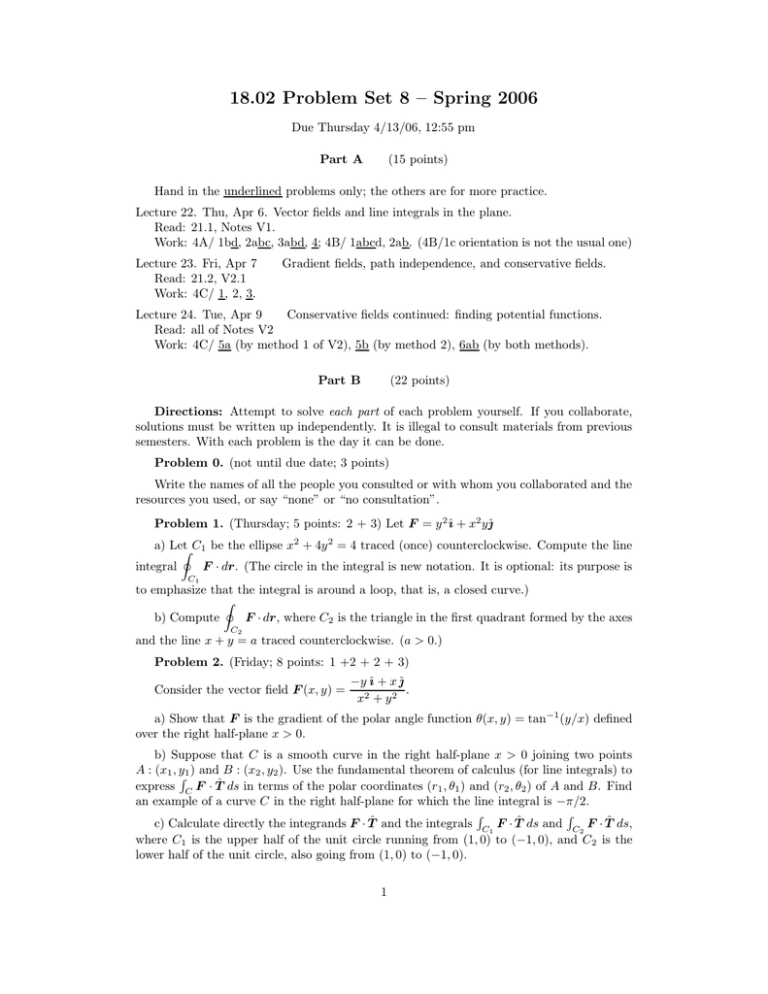
18.02 Problem Set 8 – Spring 2006 Due Thursday 4/13/06, 12:55 pm (15 points) Part A Hand in the underlined problems only; the others are for more practice. Lecture 22. Thu, Apr 6. Vector fields and line integrals in the plane. Read: 21.1, Notes V1. Work: 4A/ 1bd, 2abc, 3abd, 4; 4B/ 1abcd, 2ab. (4B/1c orientation is not the usual one) Lecture 23. Fri, Apr 7 Read: 21.2, V2.1 Work: 4C/ 1, 2, 3. Gradient fields, path independence, and conservative fields. Lecture 24. Tue, Apr 9 Conservative fields continued: finding potential functions. Read: all of Notes V2 Work: 4C/ 5a (by method 1 of V2), 5b (by method 2), 6ab (by both methods). (22 points) Part B Directions: Attempt to solve each part of each problem yourself. If you collaborate, solutions must be written up independently. It is illegal to consult materials from previous semesters. With each problem is the day it can be done. Problem 0. (not until due date; 3 points) Write the names of all the people you consulted or with whom you collaborated and the resources you used, or say “none” or “no consultation”. Problem 1. (Thursday; 5 points: 2 + 3) Let F = y 2 ı̂ + x2 yˆ� 2 2 a) Let � C1 be the ellipse x + 4y = 4 traced (once) counterclockwise. Compute the line integral F · dr. (The circle in the integral is new notation. It is optional: its purpose is C1 to emphasize that the integral is around a loop, that is, a closed curve.) � b) Compute F · dr, where C2 is the triangle in the first quadrant formed by the axes C2 and the line x + y = a traced counterclockwise. (a > 0.) Problem 2. (Friday; 8 points: 1 +2 + 2 + 3) Consider the vector field F (x, y) = −y ı̂ + x ˆ� . x2 + y 2 a) Show that F is the gradient of the polar angle function �(x, y) = tan−1 (y/x) defined over the right half-plane x > 0. b) Suppose that C is a smooth curve in the right half-plane x > 0 joining two points A : (x1 , y 1 ) and B : (x2 , y2 ). Use the fundamental theorem of calculus (for line integrals) to express C F · Tˆ ds in terms of the polar coordinates (r1 , �1 ) and (r2 , �2 ) of A and B. Find an example of a curve C in the right half-plane for which the line integral is −�/2. c) Calculate directly the integrands F · Tˆ and the integrals C1 F · Tˆ ds and C2 F · Tˆ ds, where C1 is the upper half of the unit circle running from (1, 0) to (−1, 0), and C2 is the lower half of the unit circle, also going from (1, 0) to (−1, 0). 1 d) Since curl F = 0 at any point of the plane where F is defined, the vector field F ought to be conservative (path-independent). This is true in some regions, but not in others. Consider three regions, the punctured plane R1 , defined as the whole plane except the origin (0, 0), the slit plane R2 , defined as the whole plane except the negative x-axis ((0, x) where x � 0), and the right half-plane R3 , as defined in part (a). In which of the regions R1 , R2 , and/or R3 is F conservative? Even though F is not conservative in one of these regions, this does not contradict the fundamental theorem. Explain. Problem 3. (Tuesday; 3 points: 1 + 2) a) Calculate the curl of F = r n (x ı̂ + y ˆ� ). b) For each n for which curl F = 0, find a potential g such that F = �g. (Hint: look for a potential of the form g = g(r). Watch out for a certain negative value of n for which the formula is different.) Problem 4. (Tuesday; 3 points: 1 + 1 + 1) a) Verify that F = y 2 ı̂ + x2 yˆ� from Problem 1 is not a gradient field. b) Try to find a potential function by Method 1 in Notes V2. What goes wrong? c) Try to find a potential function by Method 2 in Notes V2. What goes wrong? 2
